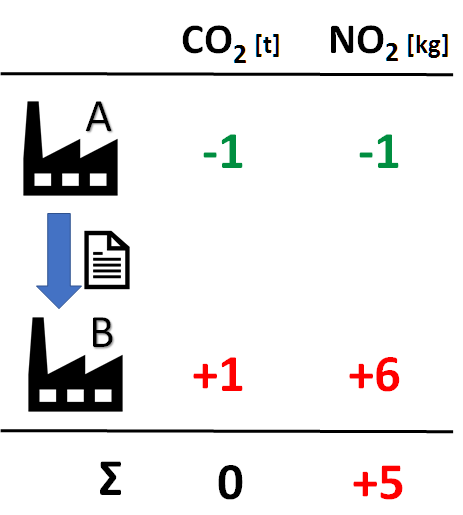Part I: Unintended Effects of CO2 trading in Europe on public health


Idea
The European Trading Scheme (ETS) is one of the world’s largest cap-and-trade systems implemented to regulate the emission of CO2. Under the ETS, firms in regulated sectors need to buy certificates per ton of CO2 emitted, while the total number of certificates available is reduced over time. Understanding the effects of such regulation is key to improve environmental policy-making as regulation becomes more important and popular in rapidly industrialising countries such as China and India as well as post-industrial societies. The demand for better air quality rises around the globe and curbing emissions is a cornerstone of policies to improve it.
However, CO2 is emitted jointly with other pollutants that are not considered under the ETS. We call these co-pollutants and a trade in CO2 certificates can actually increase their overall emission.
To understand this more intuitively, consider a simple example with two firms, A and B. Suppose both are participating in the ETS. A emits one kilogram of NO2 per ton of CO2 (i.e. producing goods that lead to emission of one ton of CO2 lead to emission of one kilogram of NO2), while B produces 6 kg of NO2 per ton of CO2. Hence, B is more pollution intensivethan A. Now, A has reason to reduce its CO2 emissions (e.g. because it has improved its production technology or faces lower demand) and sells one certificate to B. While this trade is CO2 neutral, the co-pollutants lead to a hidden rise in overall air pollution.
Additionally, it is possible that firm B lies in a more densely populated area than firm A, resulting in more people being exposed to this higher level of air pollution. While this plays no role for the individual’s health outcome, quantifying aggregate risks of air pollution and the associated social costs is of major importance to improve policy making.
This hypothetical example highlights the vast potential for implicit pollution trade to affect emission levels and public health outcomes.
Methodology
Reliably quantifying the damages due to air pollution is a challenging task for a number of reasons. Measuring an individual’s exposure to air pollution is hard as it is not taking place randomly but rather the result of multiple choices – some actively made by the individual such as moving further away from pollutant emitting factories because of pre-existing health conditions. Additionally, most studies are prone to measurement error of pollution levels. They focus on the amount of emissions in the surrounding area, however, many types of pollutants can travel far making it hard to identify the real level and sources of air pollution individuals are subjected to.
The HEAL project aims to address these issues by introducing a new framework to analyse the effects of air pollution on human’s health. This framework combines tools from causal inference and spatially detailed impact analysis with modern models of pollutants behaviour and distribution.
More precisely, we use a novel dataset that links EU ETS installations of pollution to the European Pollution Release and Transfer Register (E-PRTR) that contains information on the level of pollutants released to air, water and soil by facilities in the EU. Our process comprises multiple steps that employ sophisticated methods to understand the impact of CO2 trade on co-pollutant emissions and subsequently their effect on public health.
First, using a microeconometric model we predict the counterfactual level of air pollution in each facility when certificate trade is absent. This shows how the CO2 trade shifts co-pollutant emissions across the European continent and what areas are affected. To quantify the health outcomes in this counterfactual world we have to translate emissions into pollution exposure levels. A state-of-the-art chemical transport model that considers weather, topography and chemistry is calibrated to do so. We end up with a spatial grid containing counterfactual and real levels of air pollution exposure that allow us to calculate the treatment effect of certificate trading on public health using monetised per-capita dose response functions taken from the existing literature.
